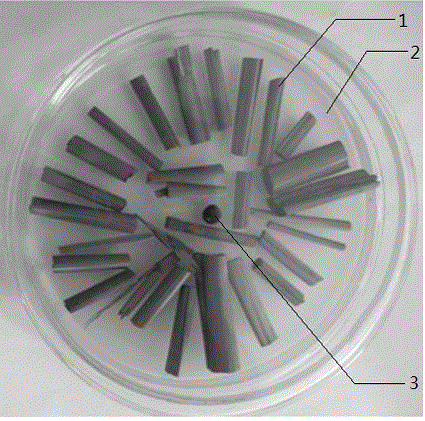Long-time preservation method of magnaporthe oryzae strain
A technology for long-term preservation of Magnaporthe grisea, which is applied in the fields of microbiology and plant protection. It can solve the problems of difficult drying of the culture medium, cumbersome recovery of strains, and sticky appearance, so as to avoid the degradation of Magnaporthe grisea strains, Save storage space and avoid fragile and fragile effects
- Summary
- Abstract
- Description
- Claims
- Application Information
AI Technical Summary
Problems solved by technology
Method used
Image
Examples
Embodiment 1
[0032] A long-term preservation method for rice blast fungus strains, specifically comprising the steps of:
[0033] Step 1: Pour the sterilized soluble starch medium into a sterilized 90mm-diameter petri dish on the ultra-clean workbench, and quickly cut the sterilized rice with a length of 20mm after the medium solidifies The rods are evenly placed on the culture medium; the composition of the soluble starch medium is: 10.0 g of soluble starch, 2.0 g of yeast extract, CaCO 3 3.0g, agar powder 16.0g, distilled water 1000.0ml, pH6.5;
[0034] Step 2: Use a sterilized inoculation needle to pick a piece of Magnaporthe grisea bacteria block with a diameter of 5mm to be preserved on the ultra-clean workbench, and place it in the center of the soluble starch medium without the rice stalk, so that the hyphae face down;
[0035] Step 3: Place the petri dish plate in a constant temperature incubator and incubate at a constant temperature of 25°C until the culture dish is covered wi...
Embodiment 2
[0042] A long-term preservation method for rice blast fungus strains, specifically comprising the steps of:
[0043] Step 1: Pour the sterilized soluble starch medium into a sterilized 90mm-diameter petri dish on the ultra-clean workbench, and quickly cut the sterilized rice with a length of 20mm after the medium solidifies The rods are evenly placed on the culture medium; the composition of the soluble starch medium is: 10.0 g of soluble starch, 2.0 g of yeast extract, CaCO 3 3.0g, agar powder 16.0g, distilled water 1000.0ml, pH6.5;
[0044] Step 2: Use a sterilized inoculation needle to pick a piece of Magnaporthe grisea bacteria block with a diameter of 5mm to be preserved on the ultra-clean workbench, and place it in the center of the soluble starch medium without the rice stalk, so that the hyphae face down;
[0045] Step 3: Place the petri dish plate in a constant temperature incubator and incubate at a constant temperature of 25°C until the culture dish is covered wi...
Embodiment 3
[0052] A long-term preservation method for rice blast fungus strains, specifically comprising the steps of:
[0053] Step 1: Pour the sterilized soluble starch medium into a sterilized 90mm-diameter petri dish on the ultra-clean workbench, and quickly cut the sterilized rice with a length of 20mm after the medium solidifies The rods are evenly placed on the culture medium; the composition of the soluble starch medium is: 10.0 g of soluble starch, 2.0 g of yeast extract, CaCO 3 3.0g, agar powder 16.0g, distilled water 1000.0ml, pH6.5;
[0054] Step 2: Use a sterilized inoculation needle to pick a piece of Magnaporthe grisea bacteria block with a diameter of 5mm to be preserved on the ultra-clean workbench, and place it in the center of the soluble starch medium without the rice stalk, so that the hyphae face down;
[0055] Step 3: Place the petri dish plate in a constant temperature incubator and incubate at a constant temperature of 25°C until the culture dish is covered wi...
PUM
| Property | Measurement | Unit |
|---|---|---|
| Diameter | aaaaa | aaaaa |
Abstract
Description
Claims
Application Information
 Login to View More
Login to View More - R&D
- Intellectual Property
- Life Sciences
- Materials
- Tech Scout
- Unparalleled Data Quality
- Higher Quality Content
- 60% Fewer Hallucinations
Browse by: Latest US Patents, China's latest patents, Technical Efficacy Thesaurus, Application Domain, Technology Topic, Popular Technical Reports.
© 2025 PatSnap. All rights reserved.Legal|Privacy policy|Modern Slavery Act Transparency Statement|Sitemap|About US| Contact US: help@patsnap.com


